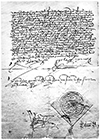The Spanish Inquisition
Part 1: Setting the Stage The Spanish Inquisition raged for two centuries, punishing, often violently, people who didn't adhere to the Catholic faith and teachings. The Inquisition began in 1231, with a bull issued by Pope Gregory IX that set up a tribunal court system to put on trial and then, usually, convict people who spoke out against the teachings and tenets of the Catholic Church. This was an offense known as heresy, and people who committed it were called heretics. It wasn't very often that people called before an Inquisition tribunal were not punished. 
The Spanish Inquisition began at the behest of political rulers, King Ferdinand II of Aragon and Queen Isabella I of Castile, whose marriage created a personal union that ruled over nearly all of what is today Spain. Pope Sixtus IV, on Nov. 1, 1478, issued the bull Exigit Sincere Devotionis, which established the Spanish Inquisition, which was officially known as Tribunal del Santo Oficio de la Inquisición (Tribunal of the Holy Office of the Inquisition). In this instance, Ferdinand and Isabella, not the Catholic Church, were in charge of the Inquisition, in their territory. The last decade of the 15th Century was a momentous year for Spain. In early 1492, Christian armies succeeded in conquering Granada, the last surviving part of the Iberian Peninsula ruled by the Moors. This completed the Reconquista, an effort by armies from all Christian powers on the Iberian Peninsula to assert their authority over their ancestral homeland. Later that year, the Italian explorer Christopher Columbus sailed on behalf of Ferdinand and Isabella to the New World, bring back word of new lands and new civilizations and the promise of plenty of wealth and power across the Atlantic Ocean. Columbus was the first of several explorers to extend the Spanish reach into the New World, and with many of these explorers went the Inquisition. 
It was also in 1492 that the monarchs, devout Catholics both, announced the Alhambra Decree, which required anyone practicing the Jewish faith to convert to Catholicism or to leave Spain entirely. The issuing date of the decree was March 31; Jews living in Spain had four months to leave, and they were forbidden from taking any horses, weapons, gold, silver, or money of any kind with them. Sources estimate that the number of Jews who left Spain at this time to be in the tens of thousands. A decade later came a similar decree for Muslims living in Granada; a great many converted to Christianity rather than leave their homes. Many of those recently converted fell under suspicion of the Inquisition. Powerful officials known as Inquisitors suspected that Jews, Muslims, and Protestants who had publicly professed a conversion to Catholicism (in Spain known as conversos) were secretly practicing their original religion. And so, many people who were known or suspected of being unfaithful to the Catholic Church creed were rounded up and put on trial by the Inquisition. Next page > Facts, Figures, Horrors > Page 1, 2 |
|
Social Studies for Kids
copyright 2002–2026
David White




